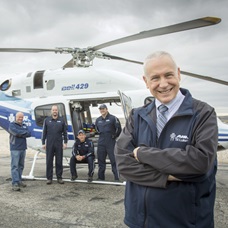Dr. Pate’s Prescription for Change
St. Luke’s Dr. Jim Souza on what care redesign looks like


When I was in practice, I was the primary physician for my patients who ended up in the ICU. I am not a board-certified pulmonary and critical care physician, and these physicians are specialists in this treatment. I also took care of these patients while tending to my “floor” patients and my office practice. If there was an urgent situation with one of my ICU patients, I would head over to see the patient.
Now, with our virtual intensive care unit, even rural patients have access to care from board-certified pulmonary and critical care physicians, and those specialists can be involved within seconds of notification that a deterioration is occurring, perhaps even before the bedside nurse makes the decision that the specialist’s help is needed and much more quickly than I could respond from home or the office.
This care has translated into better outcomes for our ICU patients and much avoided cost, and is a milestone along St. Luke’s journey to transform health care, a journey to improve outcomes while lowering the total cost of care. We are embarked on major transformative work, involving redesigning clinical care, eliminating irrational variation and incorporating advanced technology to be able to care for more patients, more efficiently, achieving better outcomes while avoiding adverse outcomes.
Here to explain our virtual care innovation from the standpoint of a specialist who delivers it is Dr. Jim Souza, chief medical officer for St. Luke’s Health System.
- David C. Pate, M.D., J.D.

It was about 1 a.m. on a Saturday in early January. I was working in St. Luke’s virtual intensive care unit, handling all initial transfers and admissions into the unit, managing all cross-cover work on critically ill adults in the ICUs across our system and monitoring those same patients using a sophisticated data-gathering system with two-way audio-visual and camera access into every room.
When in the virtual ICU, I work on a team with two critical care registered nurses (RNs) and a unit admin in our Virtual Care Center, housed in a different building from our hospitals.
One of the nurses responded to a vital sign trend and entered a room via camera in one of our ICUs. He quickly realized the case needed to be escalated and leaned over, saying, “Doc, I’ve got one for you.”
I opened the patient’s electronic health record, reviewed the detailed sign-out and got the basic history. I entered the room via camera and found an elderly woman in respiratory distress. She had an abnormal heart rhythm and was deteriorating rapidly. I remained on camera for about 35 minutes.
In that time, I ordered and interpreted multiple diagnostic tests, including an ECG, CXR, ABG and labs. I pushed multiple medications, including diuretics, narcotics, antihypertensives and antiarrhythmics, while initiating and adjusting non-invasive ventilation in coordination with respiratory therapy.
At the end of this time, the patient had great saturations, her oxygen needs were coming down, her respiratory rate was in the 20s and her heart rate was about 110 beats per minute. Crisis averted.
I should mention that during this same period, I fielded a couple of less serious adjustments to patient care plans in two different system ICUs. As I camera’d (that’s the word we use) out and leaned back, I thought about how much things had changed in just a few years.

Six years ago, before we had a virtual ICU or an integrated health record, I would have been notified later in the patient’s deterioration, because it would have required the triggering of an alarm and the decision by a bedside RN to activate me. One RN might have a different threshold than another (variation).
Once activated, if I did not happen to be immediately available, I would have had the RN’s history (variation based on the reporter) to guide my decision-making. If I’m honest about it, given the fact that the patient’s respiratory rate was in the 40s, saturations in the 80s, heart rate 180, I would likely have said, “Please contact anesthesia to intubate the patient.”
I would have made my way to the bedside and then made further adjustments. The patient might have done just fine, but she would have had an emergent placement of an artificial airway, a potentially dangerous event. The nature of her care would have been more invasive and dangerous, and the costs would have been greater.
My recent experience illustrates the essence of care redesign. It’s usually not small or incremental. It requires removing pre-existing biases about how we have historically done things, and asks, “How could we do it better to reach a higher level of quality and safety of care for our patients?”
Many health-care organizations say they are “moving to value.” Very few have made as large a commitment as St. Luke’s has to do this — more than 30 percent of our revenue is in value-based agreements.
To deliver on this population health commitment to our communities, I have been speaking to providers systemwide for the past year about reducing clinical variation and redesigning clinical care. I think some people either don’t understand the concepts or think of the terminology as jargon and “admin speak.”
In the case of the virtual ICU, we radically changed the way we care for critically ill patients at nighttime by changing attending rights for cross-cover calls, centralizing all critical care cross-cover, creating a central team of people and clinicians and developing centralized workflows to handle and triage work in order to monitor and manage a large number of patients simultaneously. We changed physician staffing models and physician compensation models, invested in and installed technology and infrastructure to support the program, established sign-out standards to facilitate safe handoffs, developed new clinical workflows to facilitate early extubation and more.
Think of the dramatic reductions in operational and clinical variation associated with this redesign. And for my clinical colleagues, think about the challenges of providing more care to more complex patients in the units or clinics you work in.
What might care redesign look like there?
About The Author

Dr. Jim Souza is chief physician executive for St. Luke’s Health System, based in Boise, Idaho. He earned his undergraduate degree in cell biology from the University of Montana and medical degree from the University of Washington School of Medicine. He served his residency in internal medicine at the University of Washington and the Boise VA Medical Center and did a pulmonary and critical care fellowship through the University of Washington and the Boise VA Medical Center. He is board-certified in pulmonary disease and critical care medicine. In addition to his administrative duties, he continues to practice pulmonary and critical care medicine.




